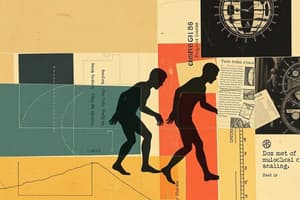Podcast
Questions and Answers
What was the primary early source of atmospheric oxygen?
What was the primary early source of atmospheric oxygen?
- Multicellular algae
- Land plants
- Eukaryotic cells
- Cyanobacteria (correct)
What significant event occurred around 2 billion years ago?
What significant event occurred around 2 billion years ago?
- The formation of banded iron formations stopped
- The first eukaryotes emerged (correct)
- Oxygen saturated the atmosphere
- The first multicellular organisms appeared
What process led to the formation of mitochondria and plastids in eukaryotic cells?
What process led to the formation of mitochondria and plastids in eukaryotic cells?
- Gene transfer
- Cell differentiation
- Spontaneous generation
- Endosymbiosis (correct)
What type of cellular structure is formed from the infolding of the plasma membrane?
What type of cellular structure is formed from the infolding of the plasma membrane?
Which of the following is true about the oldest known multicellular eukaryotes?
Which of the following is true about the oldest known multicellular eukaryotes?
What characteristic is shared by all animals according to the information provided?
What characteristic is shared by all animals according to the information provided?
During which period did the Cambrian explosion occur?
During which period did the Cambrian explosion occur?
Which of the following is considered a derived character of chordates?
Which of the following is considered a derived character of chordates?
What does the expression pattern of Hox genes along the chromosome correlate with?
What does the expression pattern of Hox genes along the chromosome correlate with?
Which organism is mentioned as a Cambrian relative to vertebrates?
Which organism is mentioned as a Cambrian relative to vertebrates?
What significant interaction is evidenced by fossils from the Cambrian explosion?
What significant interaction is evidenced by fossils from the Cambrian explosion?
Which type of fossils are described as being difficult to categorize as either animals or algae?
Which type of fossils are described as being difficult to categorize as either animals or algae?
What best characterizes the sudden appearance of fossils during the Cambrian explosion?
What best characterizes the sudden appearance of fossils during the Cambrian explosion?
What is the molecular clock primarily used to measure?
What is the molecular clock primarily used to measure?
Which method is used for absolute dating of fossils?
Which method is used for absolute dating of fossils?
What does the principle of superposition state?
What does the principle of superposition state?
Which of the following methods can be used for dating volcanic rock?
Which of the following methods can be used for dating volcanic rock?
Which ape split is estimated to have occurred around 6-8 million years ago?
Which ape split is estimated to have occurred around 6-8 million years ago?
What kind of fossils are preserved mineralized parts of organisms such as teeth and bones categorized as?
What kind of fossils are preserved mineralized parts of organisms such as teeth and bones categorized as?
What is the basis for radiometric dating methods?
What is the basis for radiometric dating methods?
How is the molecular clock calibrated?
How is the molecular clock calibrated?
What characterizes the normal rate of extinction compared to mass extinctions?
What characterizes the normal rate of extinction compared to mass extinctions?
Which event is considered part of the Big 5 mass extinctions?
Which event is considered part of the Big 5 mass extinctions?
What is the current estimated rate of extinction compared to background extinction levels?
What is the current estimated rate of extinction compared to background extinction levels?
What was the primary composition of the first cellular life forms on Earth?
What was the primary composition of the first cellular life forms on Earth?
What has been one of the significant impacts of plate tectonics on biodiversity?
What has been one of the significant impacts of plate tectonics on biodiversity?
Which of the following organisms thrived in the ancient Earth atmosphere prior to saturation with oxygen?
Which of the following organisms thrived in the ancient Earth atmosphere prior to saturation with oxygen?
What role do chemoautotrophs play in ecosystems?
What role do chemoautotrophs play in ecosystems?
What are stromatolites primarily composed of?
What are stromatolites primarily composed of?
Flashcards are hidden until you start studying
Study Notes
Molecular Clock
- Some parts of the genome accumulate changes (mutations) at a relatively steady rate.
- The speed of accumulation depends on the part of DNA under study (some fast, some slow).
- The “clock” is calibrated using the fossil record (e.g. orangutan fossils have been securely dated for apes), or the accumulation of mutations over generations.
- Using the known age of the orangutan split, plus info on orangutan DNA, we know the rate of mutations in certain parts of the ape genome.
- Count known differences in DNA between humans and chimps.
- The data indicates a date of the split between Pan and Homo at about 6-8 million years ago.
Paleontology: Scientific study of fossil organisms
- Fossils are preserved mineralized parts of organisms (shells, teeth, bone).
- Trace fossils left by organisms (indirect evidence).
- Coprolites and other remains.
- More rarely: soft parts preserved as minerals.
Paleontology: Dating fossils
- Relative dating: Principle of superposition; any layer of sedimentary rocks is older than the layer above it and younger than layers below it.
- Absolute dating (chronometric): Radiometric dating.
- Uranium series dating (U-Series): 238U turns to lead (Pb) – Series of half-lives (several isotopes, 100 000s to billions yrs).
- Argon-Argon (40Ar-39Ar) dating is often used on volcanic rock - 1.25 billion year half-life.
Patterns of Extinctions
- Background Extinctions: “Normal” slow rate of extinction; 96% of extinctions.
- Mass Extinctions: Global extent; Broad range of species; Often rapid.
- Five major mass extinctions: Some mark the ends of geologic eras.
- 6th Mass Extinction? 1,100 species extinct since 1600.
- Habitat loss, hunting, introduction of non-native species.
- Previous mass extinctions took at least 5 million years to recover species diversity.
- The current rate of extinction is 100-1000X larger than background extinction.
Plate Tectonics and Continental Drift
- Movement of continents (Pangea 250 million years ago).
- Formation of mountain ranges, leading to movement and separation of species.
- Can also explain some changes in climate.
3.5 Billion Years Ago: First Evidence of Cellular Life
- The oldest known fossils are stromatolites, geological structures composed of many layers of photosynthetic cyanobacteria and sediment.
- Date back to 3.5 billion years ago.
- Prokaryotes were Earth’s sole inhabitants from 3.5 - 2.5 billion years ago.
- Prokaryotes typically have a cell wall outside the phospholipid plasma membrane.
2.5 Billion Years Ago: Atmosphere Becomes Saturated With Oxygen
- Atmospheric oxygen (O2) is of biological origin.
- The early source of O2 was likely cyanobacteria.
- O2 produced by photosynthesis reacted with dissolved iron and precipitated out to form banded iron formations.
Ca 2 Billion Years Ago: First Eukaryotes
- Oldest eukaryote cells ca 2 billion years ago.
- Related to archaeans.
- Nuclear membrane formed from infolding of plasma membrane.
- Endosymbiosis: mitochondria and plastids (chloroplasts) were formerly small prokaryotes – engulfed by a host cell.
- Mitochondria and plastids have their own DNA and replicate in a way similar to bacteria.
1.5 Billion Years Ago: Multicellular Eukaryotes
- Oldest known fossils of multicellular eukaryotes are tiny multicellular algae from around 1.5 billion years ago.
- More diverse multicellular organisms do not occur until around 600 million years ago (Precambrian).
Early Animals
- Enigmatic Precambrian (Ediacaran) fossils: some are hard to identify as either animals or algae.
- Some are definitely the earliest animals, ca 600 million years ago (no vertebrates).
Animals
- Earliest animals ca 600 million years ago, implying a peculiar genetic mechanism evolved by then.
- Homeotic genes containing a highly conserved 180-nucleotide “homeobox” are called Hox genes.
- Hox genes code for the body axis position in very different animals.
- The position of Hox genes along the chromosome is the same as the position of expression along the body axis.
Paleozoic Starts ~550 Million Years Ago: Cambrian Explosion
- Many modern animal phyla suddenly appear in the Cambrian.
- Most of life is still in the seas, but some plants and invertebrates are found on land shortly after.
Paleozoic Era (550-250 mya)
- Starts with the Cambrian “explosion” ca 550 mya.
- First fossil chordates and vertebrates.
- Best preserved in Burgess Shale, Canada.
Cambrian Explosion
- Sudden appearance of fossils resembling modern phyla.
- Provides the first evidence of predator-prey interactions.
- More armor (shells, spikes).
Chordates
- Chordates form a monophyletic taxon, with vertebrates being the most numerous group.
- Chordate shared derived characters: notochord, myotomes, and others.
Cambrian Relatives of the Vertebrates: Ancient Chordates
- Chordates similar to the lancelet are known from the Cambrian 530 million years ago, Burgess Shale and China.
- These have the typical chordate features e.g. notochord, myotomes.
Studying That Suits You
Use AI to generate personalized quizzes and flashcards to suit your learning preferences.




